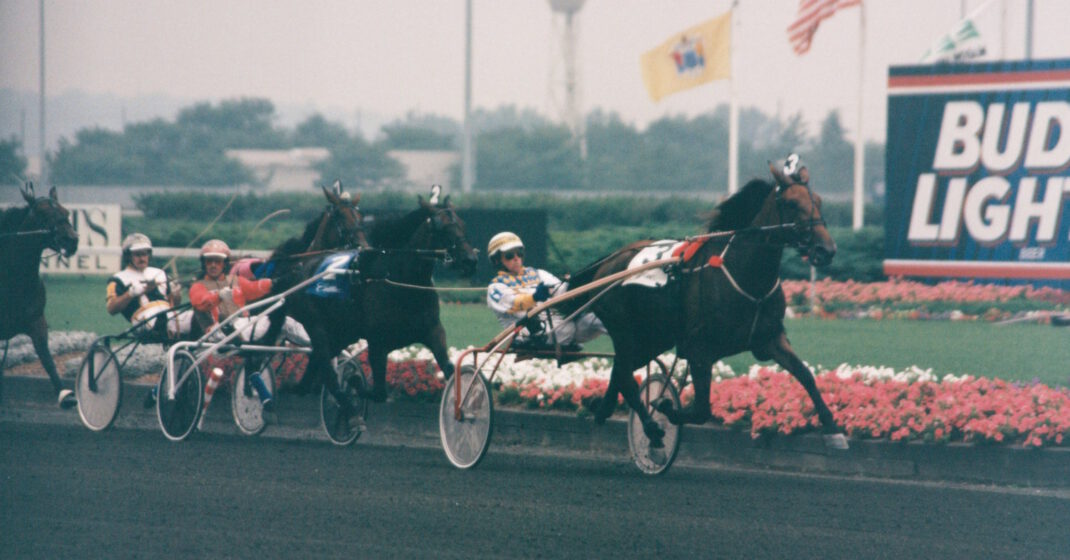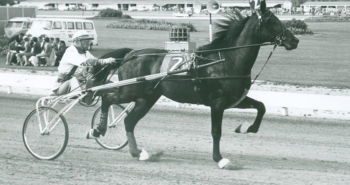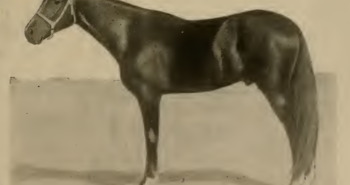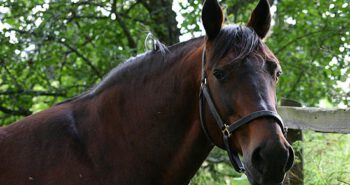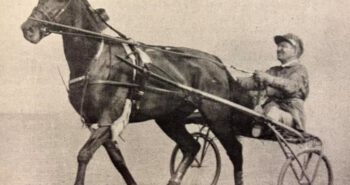She was voted the “Greatest of All Time” in an online poll in 2020, and for good reason: Moni Maker put in numerous memorable performances on two continents to forever cement her place as one of the best in trotting history. Her regular driver Wally Hennessy is certain: “She is the greatest trotter who ever lived.”
The story of Moni Maker starts with David and Fredericka Caldwell of Cane Run Farm buying Nan Hanover at yearling auction in 1978. She never made it to the races and became a broodmare at Cane Run Farm, delivering her first foal in 1982, at 5. The first two foals, both daughters by Lindy’s Pride never made it to the races, either. Her third foal, Our Nanny 1:59, by Bonefish, was a useful trotter who later was exported to Sweden where she was a good broodmare. Nan Hanover delivered her fourth foal in 1985, when Our Nanny’s full sister Nan’s Catch was born. A spectacular mare inducted into the Hall of Fame in 2008, nobody actually wanted to purchase Nan’s Catch as a yearling as the mare was simply considered too big.
The Caldwells tried to get Jan Johnson, Hakan Wallner and Berndt Lindstedt’s Continental Farms to buy half of Nan’s Catch, but they were skeptical about her size, too, and ended up training her. Any doubts about her size were soon put to rest as Nan’s Catch showed herself a class above the rest, winning 19 of 29 starts, including a Breeders Crown final at 2 and the Hambletonian Oaks, World Trotting Derby Filly and Kentucky Filly Futurity at 3. In an interview with Murray Brown in Harness Racing Update, Jan Johnson picked out Nan’s Catch as the best he ever trained. “In my heart I know that if she had been in the Hambletonian, she would have won it. As it happens, we won the Hambletonian that year with Armbro Goal, with Nan’s Catch winning the Oaks. We also had another good trotter that year in Supergill. I believe that she was better than either of them. We’ve had more than our share of top horses through the years, but I truly believe she was the best.”
“They had a presence about them”
Retired, Nan’s Catch was bred to Armbro Goal at 4 and delivered Awesome Goal, but David and Fredericka Caldwell had a clear plan who they then wanted to breed their world champion mare to. “My parents sought out Speedy Crown for Nan’s Catch because he was the best, it was a good match, and even though he was older, they wanted to get in before he got too old and had to retire. His book was quite limited at the time”, explains Elizabeth Caldwell.
Nan’s Catch had two daughters by Speedy Crown. The first was Catch Fortuna – originally named Cat Fortuna – and then came a huge filly who was named Nursery Rhyme. “She might have been even bigger than Nan’s Catch as a yearling. Her personality was much like her dam’s, they were both bossy to the other horses, definitely the leaders of the herd, but they liked attention from people. While they were both big horses, they had a presence about them. They both had beautiful heads, regal that fit their body, with a distinct eye – Nan Hanover had the same eye, too – and long ears for a trotting filly. We were partial, of course to their looks, especially since they turned out to be such a great part of the history of our farm” Caldwell adds.
Just like her dam, Nursery Rhyme’s size was a serious source of concern for potential buyers. Not everybody was scared away, though. E Carlyle, David and Timothy Smith as well as Alan Foster were happy to shell out $87,000 at yearling auction for the blue-blooded filly. Their purchase led to Wally Hennessy being associated with the huge mare, who was then renamed Moni Maker. “The people who purchased her were clients of mine and I drove a lot of horses for them. I had also known Bill Andrews for some time and driven horses for him”, Hennessy explains.
Talented but not quite there yet
As the filly was New York-bred, Moni Maker raced primarily there at 2. She qualified and started in three baby races at Vernon Downs. At first Moni Maker seemed like a nice mare, but she was no standout. She made her debut in the Acorn Stakes at the Meadowlands but broke stride and finished far behind the field. She won the Merrie Annabelle Consolation and three legs in the New York Sire Stakes but ended outside of the money in both the NYSS final as well as her Breeders Crown elimination. “Though I can’t speak for Bill Andrews, I don’t think she gave him any indications of what was to come early on. She showed talent, but was also so big it was amazing she even got around the half-mile tracks at 2 as she hadn’t fully matured. But when we took her to a mile-track and she could stretch her legs, she showed signs that she was going to be a good filly. However, throughout her two-year-old season I don’t think anybody expected what was to come”, says Hennessy.
In hindsight it was calm before the storm, but neither the trainer nor the driver realized it quite yet. In her seasonable debut in April, however, Moni Maker showed that something had changed. “During the winter, Bill Andrews had a stable right behind me at Pompano. Before he left, we qualified her and then raced her twice – and in her first start, against aged trotters, she did something not many horses could do at Pompano. I took her off the gate and we got away in a bad position. With less than a quarter mile to go she just circled the field. After the race I just looked at Billy and asked him if he saw what just happened. She did it with ease and really showed us something then”, Hennessy recalls.
“It was my fault”
After the two wins at Pompano, Moni Maker started winning … and winning … and winning. The huge mare put away the elimination and final of the Currier and Ives, the New York Sires Stakes and the Reynold Stakes. The other three-year-olds fillies were then pushed aside with ease in the Hambletonian Oaks.
Ahead of her Hambletonian Oaks triumph there had been changes in the ownership. “She just kept winning and did it so nonchalantly and easily that we didn’t think much about it. Midway through her 3-year-old campaign others were taking notice, and the original owners started to get a lot of calls from people interested in buying her. It came down to 2-3 others that were really serious. One group won out, the Moni Maker Stable headed by Lindy Farms, bought into her just before the Hambletonian Oaks. There were a few stipulations, one was that the group, who had bought in for 50 %, had no say in her races for the rest of the year, while another was that when she crossed the wire in the final race, the Moni Maker Stable owned all of her. She only lost once at 3, in the Breeders Crown at Vernon Down – and it without a doubt the best race that she had ran at that point. It was my fault, though. We got a horrible trip in a large field, and she lost by a nose”, Hennessy explains.
“It was her way or the highway”
Moni Maker’s final start at 3 was a win in the Matron Stakes final at Pompano to wrap up a fantastic season with 19 wins in 20 starts. With new owners fully in charge, Moni Maker was then moved to Hall of Fame-trainer Jimmy Takter. “They couldn’t have made a better choice, because in my mind Jimmy is the best in history. And they were thinking into the future and since they wanted to go to Europe, Jimmy was perfect for that”, Hennessy adds.
At that point Roman Kogalin took over as groom. He quickly learned to adore the big mare he simply called “Moni” or “Big Mama”, but also realized she didn’t leave much room for negotiations. “Everybody, including myself, was just there for the ride, as Moni decided what would happen. She was easy to understand; it was her way or the highway”, he states reflecting back. Moni Maker also got famous for how she refused to let Kogalin catch her. “Bringing her out to the paddock was never a problem. Bringing her in was only possible if she wanted to. It did not matter if we were 3-4 people trying to box her in a corner or bribe her with a carrot or a sugar bit – and, by the way, Moni didn’t like sugar bits anyway). She came in when she was ready and good to go. Sometimes that put me in a very tricky position, as we may have to ship to a new track or location. However, it didn’t matter to her if racetracks or people had to wait for her”, her groom explains.
Reconnecting with Wally
The new owners were keen to compete in both North America and Europe, and Takter set out to conquer the aged trots on both continents. After winning a free for all at Meadowlands on Apr 25, 1997, with Takter driving, the daughter of Speedy Crown was shipped overseas for the first time. Her first European start came in the 1997 Lotteria, the biggest race in Italy. The mare made it hard for herself with a third-place finish in her elimination, giving her a challenging post 7 in the final. Though she didn’t win, the put in a great performance. As Toss Out and Crowning Classic went all out for the lead, Moni Maker lost a lot of ground and was sitting last after a quarter. Driver Jos Verbeeck opted to send Moni Maker forward, and after going three-wide she had to trot the second half of the classic race parked outside the leader. She couldn’t stop Wesgate Crown flying past everybody down the final stretch but battled heroically to second place. Moni Maker then won her Elitlopp elimination, but the final was anticlimactic as Stig-H Johansson gave a tactical masterclass with Gum Ball to steal the race after a relatively slow initial half. Moni Maker was unable to impose herself and finished fifth. After then winning the Fina Cup, for aged mares, at Biri, Norway, Moni Maker returned back to the States.
In Europe, Verbeeck and Johnny Takter had been the drivers. Back in the US, Moni Maker was reunited with her old driver as Wally Hennessy would drive the mare in most races for the rest of her career. That summer he drove her to victories in the elimination and final of the Nat Ray and the Classic Oaks as well as a second place in the Breeders Crown Open Trot behind Wesgate Crown. Moni Maker and Hennessy had already won several big races together, but now the mare would take the Charlottetown native on the trip of a lifetime. “As faith would have it, I reconnected with her again. Driving Moni Maker was a career in itself, and if that was all I ever did it would be considered a tremendous career. She took us on a journey that nobody could ever dream about.”
Going back to Europe in late October 1997, the still four-year-old Moni Maker then started in six races in Italy, going 2-2-2 against elite trotters. One of these wins was a hugely impressive performance in the Gran Premio delle Nazioni where the mare, driven by Johnny Takter, easily brushed aside opponents like Wesgate Crown, Huxtable Hornline, CR Kay Suzie and Dryade des Bois, winner of the Prix d’Amerique two months later. From Italy she started twice in France, finishing second in the 1998 Prix de France and third in the Grand Criterium de Vitesse at Cagnes-sur-mer. Back in Italy she was third in the Lotteria after Johnny Takter copied Stig-H Johansson’s tactics from the previous Elitlopp: after a relatively slow first half, it became too difficult for the big mare to make up too much ground. It was the one tactic which defeated Moni Maker on a few occasions as the front runner then held all the aces.
A brutal preparation
After a second-place finish in the Oslo Grand Prix, Jimmy Takter then decided on something slightly unusual ahead of the 1998 Elitlopp. He wasn’t going to let the mare take it easy and “rest her way to top form”, instead he wanted to “wake her up.”
“It was an awe-inspiring thing when Moni did was a prep mile at Jägersro, Malmö, one week ahead of the Elitlopp. She actually went a world record, though it wasn’t official. Jimmy had asked Bo William, his dad, to help us. Bo went an easy first quarter with her in 27 seconds and the last quarter in 26.2 seconds, and she was clocked in 1.10,7 (1:53.4f). What made that so special was that it was a training mile seven days before the Elitlopp. I remember the local press went crazy and questioned how we could do something like that just seven days before one of the biggest races of the year. In Jimmy’s typical style he stated that we needed to wake her up so she could leave the gate. The rest is history, I guess,” Kogalin adds with a smile.
A double world record performance
Even most elite trotters would struggle to muster energy for a gruelling two-heat Elitlopp after trotting a world record in training just seven days prior. But Moni Maker wasn’t your ordinary elite trotter. Despite a brutal trip from post 8 in her elimination, Moni Maker won in a new world record time, 1.10,9 (1:54f). In the final she was parked outside Huxtable Hornline, but made it look easy when he she lowered her own world record and won in 1.10,6 (1:53.3f). Hennessy still struggles to believe it, 26 years later.
“There is no possible way any other horse could do what she did that day. I gave her such a tough trip in both the elimination and final. Never mind winning the final, she shouldn’t even have gotten a cheque. I had her all over the racetrack – I was four wide at the quarter in the elimination and parked outside in the final. That performance…” he says, letting the words hang in the air. “I shouldn’t say never, but there will never be a horse that will do two races like that again.”
Though some might have wondered if Hennessy had completely lost his head, but his strategy was based on his experience with the big mare: he trusted her completely.
“Through her career nobody told me how to drive her, and Jimmy and the owners trusted me. However, I would never have driven another horse the way I drove her that day – and if I did that horse wouldn’t even make it to the final. Moni Maker, though, instilled so much confidence in me – and I have my own confidence on top of that. She could do everything. Even when it looked hopeless, she got it down. Every race with her was high profile, but she never allowed the pressure to get to me because of the confidence she instilled”, he explains.
And did Moni Maker have any weaknesses?
“If there is one factor, though not a negative, it is that she lacked gate speed like some European horses. If she had more gate speed I wouldn’t have been in some of the tough situations. However, Moni Maker was so big she couldn’t have that high acceleration, so she was always in the situation where she was two- or three wide early. But it didn’t matter. She had a flawless gait and a determination to win. As a driver you sometime tell yourself to not move early, but with her I never had that feeling. She was the easiest horse to drive. Also, it could be 20, 30 or even 40,000 people screaming, but nothing affected her. She was always focused.”
Conquering Vincennes
Back in the US, Moni Maker continued to assert her dominance with wins in the Nat Ray and Breeders Crown Open Trot. In early November she left for her third European trip, pickin up three big wins in Italy in Nov and Dec 1998 before going to France for what is perhaps the ultimate test in international trotting, the Prix d’Amerique over 2700 meters (1 11/16 mile) with a walk-up start. Moni Maker won the Prix de Bourgogne and finished third in the Prix de Belgique, making her one of the favorites in the 1999 Prix d’Amerique. Driven by one of the best young French drivers at the time, the 27-year-old Jean-Michel Bazire, Moni Maker easily won ahead of Lovely Godiva and Defi d’Aunou.
Several American-owned and -trained trotters have tried their luck in the Prix d’Amerique since Sam Williams started in 1930, but only Delmonica Hanover and Moni Maker has actually achieved the feat. Both Kogalin and Hennessy agree that the victory was one of the absolutely highlights of the mare’s career. “In most cases when you are involved with a top horse, you can pinpoint one or two highlights, but with her it was so many. The group invited me and my family to the Prix d’Amerique and I had got to watch her. It was freakish and watching it I realized I was a lucky person to drive her”, Hennessy adds.
Caldwell wasn’t that lucky. “I wanted to go, but I was in college, and my parents didn’t think I should be skipping school for a horse race”, she smiles. “But the win was one of my parents’ all time favorite experiences with Moni Maker. I don’t think they had seen a race with so much hype and fans in attendance with a special parade and all of the fanfare like that before.”
“He flew two or three meters”
By winning both the Elitlopp and Prix d’Amerique, Moni Maker joined a relatively small and exclusive group of trotters. Add in the numerous other European group-1 wins and the group contains just a handful of trotters. European fans recognized how truly special Moni Maker was, and it left a permanent memory with Hennessy.
“When she arrived at the track, not only did she have the attention of every horseman owner, groom, trainer and driver, but as soon as she came out to warm-up she got a standing ovation. The paddock could be full, and you could hardly get through, but when they saw her they made way and gave her a standing ovation. And they were all horsemen. We didn’t appreciate it as much at the time because we were in the middle of it, but it was truly special,” he explains.
Kogalin remembers one time, however, when some fans got a little too close for comfort. “We were in Italy and some people came to look at her. One of them was a reporter and he opened her gate. I told him many times not to go too close, but he just wouldn’t listen. As soon as he opened the gate and tried to take a picture, he quickly learned that this was a terrible mistake. Moni turned and kicked with both legs, hitting him on the shoulder. He flew two or three meters backward into the box gate on the opposite side of the stable. Moni didn’t like losing races, and she sure didn’t like strangers in her box.”
Fearing for her life
Moni Maker and Bazire then followed up by winning the Prix de France on Feb 7. The mare was taken back to the US but set off for Sweden again in May. A third-place in her Elitlopp elimination, however, made things very difficult in the final. Jos Verbeeck, behind Remington Crown, knew the one way to defeat the American mare and employed that strategy in the final: after an extremely leisurely first lap – Remington Crown trotted the first kilometer in 1.15,1 (a 2:00.4MR for the first 5/8) – and the leader simply couldn’t be caught. Moni Maker was still a credible second.
Returning to the States, in the Titan Cup elimination on Jun 18, 1999, things got scary. Seemingly on her way to another win, Moni Maker just stopped at the half-mile marker. Hennessy knew immediately that something was very wrong.
“I still remember it very well. She didn’t show any signs when I was scoring her down. In the race, I moved her early, but then I could sense something was wrong because she wasn’t responding normally. When I cleared to the front, I could feel something was wrong and I immediately took her back. She probably would have kept going, but I pulled her up to a walk”, he explains.
Kogalin was deeply worried. “When she got back into the paddock I measured her heartbeat and it was through the roof. We shipped her to the New Bolten Horse Hospital. The drive took four hours and upon our arrival, a team of specialists welcomed us and started to examine her. I remember well that I was scared to lose her. I was sitting there for some nine hours until a doctor came and told me she was out of danger. I remember the nurses were very nice. One of them went out bought me a pair of jeans, a shirt, socks, underwear, and towels because I had nothing with me. In the following days, I spent 12-14 hours in front of her box, ensuring she knew I was there and that she was not alone. After six days, we got the final results of what happened, and we could leave New Bolton.”
Moni Maker was diagnosed with an erratic heartbeat as low potassium levels had resulted in a disruption of the electrical impulses to the heart. At some point it was doubtful that Moni Maker would return to the track, but a team effort caused the mare to return in record time. “We took our time and built her up again. Against all odds, and in typical Moni style, she was very eager to work – and when I met another horse on the jogging track, I could feel that Big Mama was not done yet. Long interval training and some speed sessions got her back in shape, and soon we were ready to race again. It was against all adds – but she was a true champion.”
Hennessy is quick to credit the whole team around the giant mare both for the recovery, but also for her career overall. “Roman was a huge part of this. He was solely with her most times as Jimmy was over in the US. Roman actually lived with this mare 24/7 on the European trips and did a great job. Conny Svensson, her blacksmith, also deserves a lot of credit because he was the only one who ever shod this mare. He always had her balanced so right and she won every prestigious race that could be won. And I must also give credit to Phil Tuttle, her groom at 2 and 3. He trained her and warmed her up before the races and was a huge part of those two seasons.”
An off-day
Moni Maker returned in style with five wins in six starts, including an impressive 1:53.4 (1.10,7) win in the American-National at Balmoral. Returning to Italy yet again, Moni Maker won four of five starts in November and December of 1999 – she only came up short in the Gran Premio delle Nazioni where a certain four-year-old Varenne defeated her. However, she won the prestigious Gran Premio dei Comuni at the half-mile track in Montegiorgio, showing she mastered all track sizes after convincing wins in both her elimination and final.
Staying in Europe during the winter, she won the Grand Criterium de Vitesse, Gran Premio Costa Azzurra and Gran Premio San Paolo. After a surprise loss to Tome de Sousa in the Lotteria elimination, Moni Maker showed she had an off-day when she went off-stride in the final won by Varenne. Takter and the owners then decided to skip the 2000 Elitlopp and took the mare home to the US.
Going out in style
Two months off did wonders for Big Mama, who was back in irresistible form in when she won the Nat Ray elimination. In the final she won in 1:52.1 (1.09,7) and set another world record. She wrapped up her career by winning the Trot Mondial at Blue Bonnets in Montreal, trotting the peculiar distance of 2209 meters in 2:38.3 (1.11,7), yet another world record.
Even though her sulky days were over, the owners then decided to go for something completely different. Sending the daughter of Speedy Crown against time under saddle at the Red Mile on Oct 6, 2000, the hope was the Moni Maker would beat Preferential’s 1:58.2 (1.13,5) world record. As it turned out, that was child’s play for Moni Maker who came home in 1:54.1 (1.11,0). Though Julie Krone was in the saddle, Takter and Hennessy were also on the track, driving each of the two thoroughbred prompters.
“It was a very emotional time. You knew it had to end, but still… And there she was in her last race and broke the world record by over a full second. And when that was done … Racing in Europe the owners had seen monte races and got the idea of sending Moni Maker off to her broodmare career by a time trial under saddle. It turned out to be another part of her glorious career and certainly another emotional day. The Red Mile on that final day, it was standing room only. It was the end of a fairytale. It was an amazing voyage”, says the Canadian-born driver.
Moni Maker retired the richest female in history and was the 12th trotter win both the Elitlopp and Prix d’Amerique (not long after Varenne became the 13th and last trotter to achieve this). She won races in seven different countries and was the only Hambletonian Oaks winner to take home either the Elitlopp or the Prix d’Amerique. She was Horse of the Year in both 1998 and 1999 in the US, Dan Patch Trotting Mare of the Year from 1997 through 2000 and is inducted into the Hall of Fame.
Kogalin is certain there was none better. “Many of her world records have been broken by other special horses due to better tracks and so on, but nobody did it like her, the hard way, being parked second over or passing the whole field three wide to win. She was the horse of the century according to Hoof Beats and other trotting magazines. To me, though, she was a friend, and it was a privilege to be a part of the team that was around her.”
Hennessy agrees. “I still have paintings and pictures of her all over my house. To me she is the greatest trotter who ever lived, and I am grateful to both ownership groups who let me drive her throughout her career. If you can show me a horse, trotter and pacer, that did what she did I would drop my case that she was the best ever. But no other horse did what she did. She beat the boys and overcame tough trips. She travelled across the Atlantic six times and kept winning over any track, any distance or starting method. Horses today don’t do that. No, the time with Moni Maker it was a special time in my life.” The top driver is also reminded by others that Moni Maker was a superstar. “I don’t want to talk about me, but I am currently just short of 12,000 driving wins. Yet, nobody asks me about any other horses I drove – the one horse people want to talk about is Moni Maker.”
Escaping death
Moni Maker lived out her life at Lindy Farms’ main farm in Connecticut. Tragedy almost struck in 2011 when a barn was overloaded with snow and part of it collapsed. Moni Maker and three other mares were trapped. Gladiator Lindy and Moni Maker survived, but Lady Starlet and My Dolly weren’t that lucky and had to be euthanized.
The legendary mare had ten foals, though the last four were embryo transfers. It was one of those that almost made her achieve immortality as a broodmare, too. Bred to the French stallion Love You produced the 2014 colt International Moni. After winning his Hambletonian elimination, many held International Moni as the likely winner of the final. However, there he was broadsided in the first turn and lost the opportunity to become achieve legendary status. Her daughter Nothing but Moni then almost delivered a winner of the big race when her son Ready for Moni, by Ready Cash, was second in 2020.
Moni Maker passed away on May 2, 2014, at New Bolton Center, after complications from colic surgery.
MONI maker
(ex. Nursery Rhyme)
Bay mare born in Georgetown, KY on Feb 23, 1993. Died in Kennett Square, PA on May 2, 2014.
Speedy Crown – Nan’s Catch (Bonefish)
105 starts: 67-18-10 – 1:52.1 (1.09,7) – $5,589,256
Breeder: David & Fredericka Caldwell (Cane Run Farm)
Owners: David & Fredericka Caldwell – E Carlyle, David B and Timothy A Smith & Alan B Foster – E Carlyle, David B and Timothy A Smith, Alan B Foster & the Lindy Racing Stable – Moni Maker Stable
Trainers: Billy Andrews and Jimmy Takter
Drivers: Brian Allen, John Hogan, Wally Hennessey, Bill Fahy, David Ingraham, John Campbell, Jimmy Takter, Johnny Takter, Jean-Michel Bazire and Julie Krone
Grooms: Phil Tuttle and Roman Kogalin

